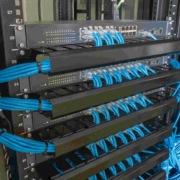CAT6A – Frequently asked Questions
CAT6A Cabling FAQ
In this article we will discuss a range of commonly asked questions regarding the Cat6a cable. These questions are what we’re frequently asked by our clients when undertaking a cabling project. So what are the frequently asked questions?
What is Cat6a cabling?
As you may already know ethernet cables are available in different shapes and sizes. The category 6a ethernet cable is an advancement of the previous Cat6. Cat6a cabling became the new structured cabling standard, ratified in 2008. Another key point, Cat6a was the first category to be suitable for 10-gigabit transmission over the standard permanent link distance of 90 metres.
Similar to Cat5e and Cat6 cables, Cat6a is constructed with 8 separate cores which are split into 4 pairs of colours. As a result, it’s classified as a twisted pair data cable. The pairs are twisted together throughout the length of the cable in designated colour groups. The Cat6a cable pairs are the same as other categories. The colours are orange, green, blue, and brown.
Category 6a cables generally have a thicker outer jacket, increased internal airspace and tighter twists. As a result, these elements reduce noise crosstalk during higher transmission speeds. It’s important to realise, these elements also mean the Cat6a cable is larger than its predecessors.
What is the Cat6a cabling speed?
As previously noted Cat6a cables are ratified for 10 Gigabit transmission over the standard permanent link length of 90 metres. Prior to this Cat6 was only capable of 10 Gigabits up to 55 metres.
The maximum frequency for cat6a cable is 500Mhz, this is an increase from 250Mhz produced by Cat6 cables. Lastly, it’s a significant increase from 100Mhz produced by Cat5e cables.
What is Cat6a RJ45 wiring?
Most of structured cabling is terminated using RJ45 termination standard. The RJ45 termination standard is found in Cat5e, Cat6 and Cat6a. In the above categories similar elements of the RJ45 connector still exist but with the addition of 4 connection points. With this in mind, all the categories still plug into one another, allowing them to be backwards compatible.
There are 8 core colours within the connector which are split into 4 pairs. The pairs are twisted together, and the tightness of the twists increase by category. The colour pairs are Blue, Green, Orange, and brown. These are consistent throughout the patch panel, module, and cable. Furthermore, they are also consistent through structured cabling categories. Regardless of the structured cabling category, transmission still occurs.
How Much is Cat6a Cabling? (Cat6a price per point)
You’re looking at roughly £50 – £65 per point. Its important to realise, the cost will depend on several factors. The structure, total number of outlets, and scheduling will affect the price.
Cat5e vs Cat6
Cat6 is an advancement of the previous category of data cables (Cat5e). The main difference between the two is that Cat6 has a bandwidth of 250mhz in comparison to 100Mhz of Cat5e. However, at the standardised 90m permanent link distance they both only transmit 1 gigabit ethernet speeds. On the other hand, Cat6 is capable of 10 Gigabit ethernet up to 55 metres.
Cat6a vs Cat6
Cat6a was the category of structured cabling ratified after Cat6, the A stands for Augmented. Some manufacturers produce another cable branded as Cat6e (Enhanced Cat6) cable. However, this category is not ratified by regular standards.
The first difference between the cables is the bandwidth capability. In comparison to Cat6, Cat6a has an increased bandwidth of 500Mhz. Cat6 bandwidth is limited to 250Mhz.
Structured cabling bases its standards around 90 metres permanent link and an allowance of 10 metres for both patch leads. The other difference between these two categories is Cat6a cabling is standardized for 10 Gigabit transmission over 90 metres. Cat6 cabling was only capable of 10 Gigabits over 55 metres.
Cat6a vs Cat7
Cat6a and Cat7 cables differ in a few ways. Cat 7 cables have an increased amount of shielding, each pair of transmission cores is shielded. The overall cable is also shielded. This is only present in Cat6a F/FTP versions. In other versions of Cat6a the outer sheath or inner cores are not shielded.
Cat7 has an increased performance regarding signal-to-noise ration protection. Cat7 is constructed in a different way which results in a larger cable and installation bend radius.
One of the main differences between the 2 cables is the transmission capability. Cat6a operates at 500Mhz, Cat7 has a maximum frequency of 600Mhz. Some Cat7a manufacturers have the capability of reaching 1,000Mhz. Both cables are ratified to transmit 10 Gigabits at 90 metres. However, tests in some Cat7 cables revealed the ability for 40 Gigabit up to 50 metres and 100 Gigabits up to 15 metres.
What is shielded Cat6a cabling
There are two main types of cable differences between Cat5e and Cat6. The cables either come shielded or unshielded. However, with a Cat6a there are 3 different variations.
Comparatively, the shielded cables look very similar in many ways. The addition of a foil shield around the cores or around the outer sheath increase the size of the cable. The shielding adds protection from EMI and external noise.
- U/UTP Cat6a – This Cable has unscreened inner cores and no screen around the 4 pairs (under the outer jacket)
- F/UTP Cat6a – Much alike the above, this cable has no shielding around the inner cores. However, it has an overall shield surrounding the 4 pairs under the outer jacket.
- F/FTP Cat6a – This cable is the total shielding solution. The inner pairs are each shielded, and the 4 pairs are surrounded by an overall shield.
Can I run HDMI over Cat6a
When it comes to sending HDMI signals over structured cabling, Cat6a is a great choice. The Shielding found in Cat6a is suitable for audio-visual transmission with better protection from interference on the AV signals. Many audio-visual manufacturers have created a specific HDMI transmission twisted pair cable. The performance delivered by these cables is almost identical to Cat6a. In these transmission links then source equipment converts the HDMI signal into a suitable transmission for the Cat6a cable. The receiving end reverses the conversion from structured cabling to HDMI.
What is Cat6a Jack
Majority of Cat5e and Cat6 cabling terminations are completed with a module. A termination module is a one-piece unit that contains the RJ termination outlets and a plastic casing which fits directly into a faceplate. At the patch panel end, all 24 terminations are prebuilt into the panel.
When it comes to Cat6a cable terminations, a termination jack is used. It’s a square termination block where the cable is connected. This is the same for the user outlet and patch panel end. The jacks are then snapped into suitable shutters that fit a floor box or faceplate. In addition, the patch panels have 24 empty slots that the jacks snap into. A termination jack allows the cable to be terminated in a straight line thus, allowing the termination standards and bend radius to be maintained. This is unachievable with a standard module.
Can I Join Cat6a cables?
The general advise with all structured cabling is that the cables should be a direct link with no joins. Be that as it may, in some cases you may have no choice but to join the cables. In this case its possible to use an inline IDC connector. To achieve this, a junction box is used to permanently punch down two Cat6a cables at opposite ends of the junction box. The box then creates a permanent join between the cables. When you use this method, the cable will still pass a fluke certification test.
We’d recommend against extending two Cat6a cables with a patch lead and jacks or couplers. The patch lead will create an addition loss in the link, and it can cause the overall link to fail when tested.
What are my options for Cat6a outdoor cable?
The two available options for Cat6a outdoor cables are,
- Standard Cat6a outdoor cable. This Cat6a outdoor cable is similar to an interior cable. However, instead of an LSOH or CCA sheath, it has an outdoor rated sheath that is suitable for exterior elements. The sheath is also UV resistant and weatherproof.
- Armoured Cat6a outdoor cable. This cable will have the same sheath as the above cable. Additionally, it also has armoured protection within the sheath which has strands of armoured wired. The wire protects the cable from rodents, strikes and any other destructive elements.
Can you use Cat6a cable for telephone outlets?
Majority of telephone systems now operate on the VOIP transmission protocol. Current VOIP systems run at 100MB or in some cases over a 1 gigabit transmission links. Therefore, all structured cabling systems are suitable to run VOIP.
Structured cabling designs ensure that all technology can work over any of the provided cabling outlets. The phones would operate over the same links as the computer and vice versa.






Share this entry